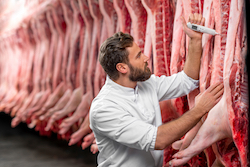Accurate carcass grading systems for the pig slaughtering market
In the meat industry, not all pigs are made equal. Tenderness, juiciness and flavour will highly depend on a pig’s breeding, age, feeding and management over its lifetime, so it seems only right to price each carcass accordingly. This system is called pig carcass classification, and it’s essential to ensure fair payment to the producer. The EU has established a regulation to base this classification on total lean meat content in relation to weight. But the truth is, producers are still not entirely satisfied with available calculation systems, and abattoirs are increasingly interested in establishing more accurate methods to sort carcasses and meat primal cuts based on their lean meat content. “Most small and medium-sized processors currently use manual probes based on optical reflectance for grading the carcasses. Such probes are relatively inexpensive, but cannot provide lean content information on primal cuts, and need to be handled by a trained operator,” says Diarmaid Heussaff, General Manager of GM Steel. Of course, automatic commercial grading systems – based on vision or ultrasonic technologies – do exist. The ultrasonic equipment can predict lean content in primal cuts by scanning the whole carcass in horizontal position while vision systems performs the classification in vertical position. But these require the carcass to be correctly split and properly presented in front of the cameras. This is context in which GM Steel’s gmSCAN technology is meant to thrive. It provides reliable prediction of total lean meat percentage and of primal cuts’ composition before the carcass is even split: “The vertical configuration of the scanner facilitates the integration of the equipment in the slaughter line and significantly reduces integration costs, and we see it as a competitive alternative to existing automatic systems,” Heussaff says. Magnetic induction is at the heart of this breakthrough. Developed in collaboration with Lenz Instruments, this method is contactless – thereby preserving the integrity and physical characteristics of the meat – and analyses the response of the fatty and lean tissues when subjected to a variable low-intensity magnetic field. The carcass is conveyed through a magnetic field generated by a bank of excitation coils. Each coil is activated in sequence and the resulting magnetic field is detected by a set of receiver sensors. At a certain frequency range, the determination of lean meat content in a carcass becomes possible due to the differences in the dielectrical properties of fat and bones compared to lean tissues. Coming soon in your country Two gmSCANs were successfully trialled during the project, respectively in Spain and Poland. Although the team is confident that the equipment is now ready for commercialisation all across the EU, it still needs to be tested and approved by each national regulatory authority. GM steel will therefore target Spanish and Polish pig slaughtering markets first, to gain industry acceptance of the technology. “We expect to target the pig slaughtering market in other countries in due course. Current grading methods can and will still be used, especially for smaller factories, but the gmSCAN system will prove attractive to medium-sized producers who previously found the cost of automatic systems prohibitive. For larger producers, it offers same or similar information to the most expensive systems on the market, but at a much lower cost,” Heussaff concludes.







